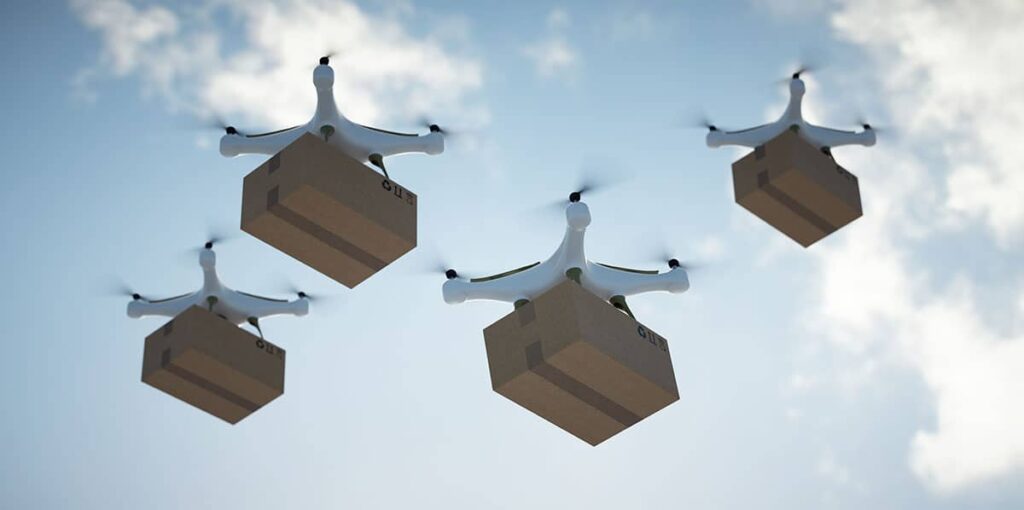A Drone Swarm is Coming, and It’s a Game-Changer
Drones remain one of the modern era’s most disruptive technologies. Drone technology continues to evolve and prove itself useful in an ever-growing list of applications.
Improved battery performance, higher-quality sensors, payloads with expanded capabilities, and more intuitive artificial intelligence, all promise to keep drone technology at the forefront of the foreseeable future.
But what will be the next significant advancement in UAV technology?
Many people believe drone swarm technology represents the next major leap forward for drones. The technology already commands the attention of militaries around the world, and commercial interest is growing.
Even entertainment industries and advertisers are taking note of swarms. A great example is Korean car manufacturer Genesis and their record-breaking 3,281 drone show introducing the automaker to China on April 5, 2021.
While drone light shows are scripted and not actual swarms, they hint at the potential for the technology.
You may be wondering what exactly swarm technology is and what role it can play in UAV applications.
If so, you are not alone. Here is a breakdown of what the drone technology is and some of the potential uses of swarm technology specific to drones.
What Exactly is Swarm Technology?
The idea for swarm robotics has its origins in the natural world. Scientists have long studied birds’ flocking behavior and the highly orchestrated marching of ant colonies.
In 1989, Gerardo Beni and Jing Wang first coined the term Swarm Intelligence, marking the beginning of swarm robotics.
Drone swarms represent a collection of UAVs that communicate with each other to accomplish a task as one cohesive unit.
Academic research and experiments at renowned institutions, such as Harvard’s Wyss Institute, have proved that autonomous artificial swarms of robots have huge potential for a wide range of applications. Drone technology is taking the knowledge of terrestrial robots and applying it to the skies.
The Specifics of Swarming
Research and innovation create pathways for drones to assist in agriculture all of the time.
In Japan, scientists created insect-size drones capable of pollinating flowers in the same manner as bees. The drones use GPS to select the optimal flight path for pollinating all plants in a given area. As the world faces a crisis in dwindling bee populations, drones may very well become a replacement pollinator.
Earlier this year, a team in Canada announced the development of a drone used for planting trees. Using a pressurized air cannon, the team successfully fired small pods of seeds into the ground. The group estimates a single drone operator would be capable of planting 100,000 seed pods per day, with the goal of planting one billion trees by 2028.
The agricultural community is just scratching the surface of what drone technology can provide to the industry. As research continues and engineers find new ways to integrate aerial data collection into farming operations, we are likely to see significant jumps in crop production.
Now is the ideal time for stakeholders and decision makers involved in agriculture to consider the integration of UAS technology into their operations. With low barriers to entry, and the promise of greater efficiencies, it will soon be difficult to imagine successful operations without drones.
Drone Swarm Applications
Nearly all of the currently used cases for drone technology can also be accomplished by swarms. Using an entire swarm instead of a single unit undeniably decreases the time while increasing the data for any given mission.
Military applications for UAV swarms are gaining quite a bit of attention in the world today. Nations worldwide are racing to develop working systems for use as intelligence gathering platforms and of course, weapons.
Commercial applications may not be getting as much financial backing as military projects, but are likely to in the future. As is typically the case, once defense agencies develop and improve the drone technology, it will trickle down to the commercial world.
For instance, construction sites could easily benefit from the power of a drone swarm. Some drones could collect photos for project management teams, while others perform inspections of the build.
Additional drones in the swarm could monitor the site for resource allocation and security. Others could make sure people are safe and bring supplies to workers as needed.
All of these could happen simultaneously without any concern for drone collisions or inefficient movement.
The possibilities for drone swarms are nearly endless.
While military applications may be the first to harness the power of swarms, commercial applications will not be far behind them. If you have ever seen the benefits of a single drone in action, imagine the possibilities of dozens or even hundreds of UAVs, all working in concert towards a collective goal.
Caution will need to be taken with the power of this technology, but it has the potential to propel drones to the next level.

David Daly - Contributing Author
David Daly, is an award-winning photographer/writer and licensed (FAA) Commercial sUAS pilot. A graduate of the United States Naval Academy, David is a former Marine Corps officer with a BS in Oceanography and has earned his MBA from the University of Redlands. David has worked for Fortune 100 companies and has a background in aerospace, construction, military/defense, real estate, and technology.



